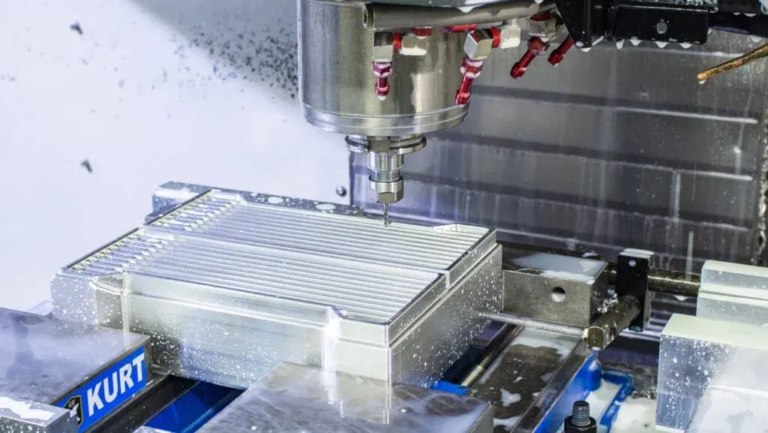The Rise of CNC Granite Cutting: Redefining Precision and Speed
Granite, a stone known for its durability and natural beauty, has become a staple in countless applications, from kitchen countertops to monumental sculptures. However, realizing its potential requires precision and control, which has traditionally been achieved through labor-intensive and time-consuming methods. Today, computer numerically controlled (CNC) granite cutting is revolutionizing the industry, delivering unprecedented precision, speed and efficiency.
This article takes a deep dive into the world of CNC granite cutting, exploring its benefits, applications, and the future of working with this remarkable material.
Challenges of Traditional Granite Cutting
Before the advent of CNC technology, manipulating granite was a challenging job. Traditional methods rely heavily on manual labor using diamond blades and polishing tools. This approach has several limitations:
- Limited precision: Achieving complex designs and tight tolerances is difficult and often results in inconsistencies and defects.
- Production speed is slow: Cutting and polishing granite by hand is a slow and arduous process that limits throughput.
- High labor costs: The need for skilled craftsmen translates into significant labor expenditures, increasing the overall cost of granite products.
- Material waste: Inaccuracies in the manual cutting process can lead to material waste, which is a significant issue for both cost and environmental reasons.
- Operator fatigue and safety issues: Prolonged exposure to dust, noise, and heavy lifting can create safety risks for workers.
CNC Granite Cutting: A Paradigm Shift
CNC granite cutting utilizes computer-controlled machinery to precisely shape and cut granite slabs. These machines are equipped with diamond blades or water jet cutting machines and are guided by sophisticated software programs. The benefits of this technology are revolutionary:
- Unparalleled precision: CNC machines can achieve millimeter-level tolerances, ensuring accurate and consistent results. This allows for complex designs, intricate shapes and perfectly mounted components.
- Improve speed and efficiency: The automated process significantly reduces cutting and polishing time, thereby shortening production cycles and increasing output.
- Reduce labor costs: CNC machines require minimal human intervention during operation, reducing the need for skilled labor and lowering overall costs.
- Minimize material waste: Precise cutting minimizes material waste, optimizes resource use and reduces environmental impact. Advanced software also allows for optimal cutting and nesting in granite slabs, maximizing yield per piece.
- Enhanced security: Automated operations reduce the risk of operator injury associated with manual cutting and polishing. The enclosed environment also helps control dust and noise levels.
- Complex geometry functions: CNC granite cutting unlocks the ability to create complex 3D shapes and complex designs that were previously impossible using traditional methods. This opens up new possibilities for architectural elements, sculptures and custom-designed components.
CNC granite cutting process
The CNC granite cutting process generally includes the following steps:
- Design and programming: Use CAD (Computer Aided Design) software to create the desired shape or design. The design is then converted into a CNC program that directs the machine to make precise movements of the cutting tool.
- Material preparation: Carefully select a granite slab and place it on the workbench of your CNC machine. Clamps or a vacuum system hold the sheet in place to prevent movement during cutting.
- Cutting execution: CNC machine tools follow programmed instructions to move the cutting tool along a specified path. In the case of waterjet cutting, high-pressure water mixed with abrasives erodes granite. For diamond blade cutting, the blade can cut through stone with precision.
- Finishing and Polishing: After cutting, granite pieces may undergo further finishing processes such as polishing, grinding, and edge profiling to achieve the desired surface finish and aesthetic appeal. Modern CNC machines can often incorporate these finishing steps directly into the cutting process, further streamlining production.
Application of CNC granite cutting
The applications for CNC granite cutting are wide and varied:
- Countertops and vanities: CNC cutting ensures accurate dimensions, smooth edges, and perfect sink cuts for kitchen and bathroom installations. The precision enables the creation of complex edge contours and decorative details.
- Flooring and Paving: CNC machines can produce granite tiles and pavers in precise sizes and shapes for flooring and outdoor applications.
- Architectural elements: CNC cutting helps create custom granite facades, cladding and decorative features on buildings. This allows architects to incorporate unique designs and intricate patterns into their projects.
- Monuments and sculptures: Artists and sculptors use CNC technology to create complex and intricate granite monuments and sculptures with stunning precision.
- Customized signage: CNC cutting enables the production of precise and durable granite signage for businesses and public spaces.
- Industrial components: Granite’s inherent stability and wear resistance make it suitable for certain industrial applications, where CNC cutting ensures the necessary precision and tight tolerances. This includes components of precision instruments and measuring equipment.
Gretel: Your precision CNC machining partner
For companies seeking professional CNC granite processing services, huge light Stand out as a reliable and experienced partner. With advanced five-axis CNC machining equipment and a team of skilled technicians, Honglaite can handle the most complex projects with precision and efficiency. Great Light specializes in solving complex metal part manufacturing problems, but their expertise also extends to granite and other materials. They provide a one-stop solution including post-processing and finishing services to ensure the highest quality results.
The future of CNC granite cutting
The future of CNC granite cutting is bright, and continued advancements in technology promise to bring more powerful capabilities. Integration with artificial intelligence and machine learning algorithms will further optimize cutting paths, reduce waste and increase efficiency. The development of more advanced cutting tools and techniques will allow the processing of harder and more exotic varieties of granite. As the industry continues to evolve, CNC granite cutting will undoubtedly play an increasingly important role in shaping the built environment and inspiring new forms of artistic expression.
in conclusion
CNC granite cutting represents a major advancement in the stone processing industry. Its precision, speed and efficiency have transformed the way granite is processed, opening up new possibilities in design and application. From intricate countertops to monumental sculptures, CNC technology allows craftsmen and designers to bring their visions to life with unparalleled accuracy and artistry. As technology continues to advance, CNC granite cutting will undoubtedly play an increasingly important role in future construction, design and manufacturing.
Frequently Asked Questions (FAQ)
Q: What is the difference between CNC granite cutting and traditional granite cutting?
A: CNC granite cutting uses computer-controlled machines to precisely shape and cut granite, whereas traditional methods rely on manual labor using diamond blades and hand tools. CNC offers superior accuracy, speed and efficiency compared to traditional methods.
Q: What types of granite can be cut using CNC machines?
A: Most types of granite can be cut using a CNC machine, from common varieties to more exotic and challenging stones. Specific cutting parameters and tool selection may need to be adjusted based on the hardness and properties of the granite.
Q: What are the advantages of using CNC granite cutting for my project?
Answer: The main advantages include:
- High precision: Ensure precise dimensions and intricate designs.
- Faster production: Reduce cutting and polishing time.
- Reduce labor costs: Minimize the need for skilled craftsmen.
- Reduce material waste: Optimize resource utilization.
- Complex geometry functions: Allows the creation of complex 3D shapes.
Q: What types of CNC equipment are used to cut granite?
A: The most common types of CNC equipment used for granite cutting are:
- CNC stone milling machine: Equipped with diamond blades for milling, cutting and shaping.
- CNC water jet cutting machine: Granite is eroded using high-pressure water mixed with abrasives.
Q: How much does CNC granite cutting cost?
A: The cost of CNC granite cutting depends on a variety of factors, including the complexity of the design, the size of the project, the type of granite and machine setup time. Getting a quote from a reputable CNC machining service like GreatLight is the best way to get an accurate cost estimate.
Q: What file formats are required for CNC granite cutting?
A: Common file formats for CNC granite cutting include:
- .DXF (Drawing Exchange Format): A vector-based format widely used for 2D design.
- .DWG (Drawing): AutoCAD’s native file format.
- .STL (stereolithography): A common format for 3D models.
- .IGES (Initial Graphics Exchange Specification): Neutral file format for exchanging 3D data between CAD systems.
Q: What are the finishing options after CNC granite cutting?
A: Common organizing options include:
- polishing: for a shiny and reflective surface.
- Honing: Create a matte or satin finish.
- Grinding: Remove surface imperfections and obtain desired texture.
- Edge analysis: Create decorative or functional edge shapes.
- seal: Protect granite from staining and water damage.
Q: How to choose a CNC granite cutting service provider?
Answer: When choosing a CNC granite cutting service provider, please consider the following factors:
- Experience and expertise: Look for a supplier with a proven track record in CNC stone machining.
- Equipment and Technology: Ensure suppliers have modern and well-maintained CNC machines.
- Quality control: Ask about the provider’s quality control processes and certifications.
- Communication and Customer Service: Choose a provider who is responsive, communicative and willing to work with you to achieve your specific requirements.
- Pricing and turnaround time: Compare quotes and turnaround times from different providers to find the best value.
Q: Where can I find a reliable CNC granite cutting service provider?
A: Ferrite is a professional five-axis CNC machining manufacturer with advanced equipment and technology specifically designed to meet all your CNC granite cutting needs, ready to exceed expectations in speed, accuracy and cost efficiency. Contact them today to get a quote!










































